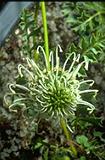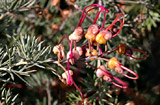|
[Front Page] [Features] [Departments] [SGAP Home Page] [Subscribe]

Tissue Culture of Grevillea Species at Mount Annan Botanic Gardens
Catherine A.Offord and Joanne L.Tyler (a)
Mount Annan Botanic Garden is the Australian native plant garden of the Royal Botanic Garden Sydney. It was established in the mid 1980s and is rapidly amassing a significant collection of Australian plants, particularly taxa from the arid, temperate, subtropical and montane tropical regions.
The Horticultural Research Section was established in 1989 and, as the name implies, its function is to further Australian horticulture, particularly in the area of conservation. The research facilities include tissue culture and seed germination laboratories and propagation glasshouses.
One of the most extensive plant collections at Mount Annan is Grevillea, a taxonomically complex genus subject to much recent reclassification. There are upwards of 340 species of Grevillea, and a large number of subspecies, forms and cultivars (Olde and Marriott, 1994) many of which are horticulturally desirable and widely grown. Unfortunately there is also a significant number of rare or threatened Grevillea taxa (164) representing approximately 3.5% of all Australian threatened flora (Briggs & Leigh, 1996).
 |
Grevillea scapigera is known from only a few populations in south Western Australia.
Select the thumbnail image or plant name for a higher resolution image (37k).
|
With help from the Grevillea Study Group, a truly significant collection of grevilleas has been amassed at Mount Annan Botanic Garden. Of the 283 taxa held, 44 taxa are considered threatened. This captive collection has given us both an opportunity to display the diversity and to research the biology and conservation of the genus. Because of the extreme rarity of some of the species, we have concentrated much effort on researching ex situ conservation of endangered Grevillea spp. through micropropagation.
Micropropagation Techniques
Grevilleas have proven to be a relatively easy group of plants to tissue culture and all of the species we have in culture (see Table 1) have been initiated and established using the same technique that was established for Waratah (Offord et al. 1990, Offord et al. 1992, Offord & Cambell 1992).
Table 1 - Grevillea species successfully propagated in vitro
at Mount Annan Botanic Garden
| Species | Endangerment Category
(National Listing) | State of Origin |
|---|
| G.batrachioides | Endangered | Western Australia |
| G.banksii | Endangered | Queensland |
| G.caleyi | Endangered | New South Wales |
| G.christinae | Endangered | Western Australia |
| G.dryandroides subsp.hirsuta | Endangered | Western Australia |
| G.flexuosa | Endangered | Western Australia |
| G.infundibularis | Poorly known | Western Australia |
| G.kennedyana | Vulnerable | New South Wales/Queensland |
| G.leucoclada | Vulnerable | Western Australia |
| G.montis-cole subsp. brevistyla | Vulnerable | Victoria |
| G.olivaceae | Rare | Western Australia |
| G.robusta | | New South Wales/Queensland |
| G.scapigera | Endangered | Western Australia |
| G.shiressii | Vulnerable | New South Wales |
| G.sspp. aff. curviloba | Poorly known | Western Australia |
| G.trachytheca | Rare | Western Australia |
| G.scabra | Poorly known | Western Australia |
Most Grevillea species grow well on MS nutrient medium (Murashige and Skoog, 1962), agar (10g/l), with the addition of BA (Benzyl adenine) at concentrations between 1.0-1.5 µM.
Although this medium is considered to have a high nutrient content, we have found no advantage in using half strength MS or other media with a lower nutrient content. Cultures are incubated at 25 ±2 °C under a light intensity of 50-100 µmol m-² s-¹, with a photoperiod of 16h/8h (day/night), for a period of six weeks. At this time, a multiplication rate of two to six times can be expected for most species, although there is some variation according to species.
 |
Grevillea banksii and its cultivars are well known in cultivation.
Select the thumbnail image or plant name for a higher resolution image (19k).
|
Once we have a plant established in tissue culture we bulk up the number to reinforce our potted collection or use the material for research purposes, such as DNA fingerprinting or nutritional experiments. One clone of Grevillea scapigera, an extremely rare species from Western Australia, has performed so well in culture that it has been used in many of our in vitro experiments, including phosphorus tolerance and the development of proteoid roots in a sterile environment. Species that are not being used for research purposes are stored using a reduced temperature and light system (10 °C and 10 µmol m-² s-¹).
Cultures are held in these conditions for many months, sometimes over two years, before regeneration. The medium used is little different to that used for other cultures (MS, BA 0.5µM), and we allow the cultures to grow at 25 °C for two weeks before being put into cool storage.
This system of storage obviates the need for regular sub-culturing, cutting labour and consumable costs, and the chance of genetic variations being perpetuated. Table 2 demonstrates some of the species that have been stored under these conditions.
Table 2 - Proteaceae species that can be regenerated after low temperature storage conditions for periods of greater than nineteen months.
| Species | Period Stored
(months) |
|---|
| Grevillea flexuosa | 30 |
| G.infundibularis | 29 |
| G.kennedyana | 19 |
| G.phanerophlebia | 29 |
| G.scapigera | 19 |
| G.shiressii | 31 |
| Hakea dactyloides | 19 |
| H.salicifolia | 19 |
| Isopogon axillaris | 26 |
| Telopea speciosissima | 31 |
Exflasking
Explants can be rooted in vitro using IBA (indolbutyric acid) 5-10 µM in the medium, although in some cases plantlets can have poor vascular connection between the roots and the shoot and may become necrotic after exflasking.
We have developed a "direct rooting" technique using microcuttings dipped in IBA powder (3g IBA/kg powder), in a similar manner to vegetative cuttings. With either method it is essential to place exflasked cultures in high humidity environment until roots are established, humidity should then be gradually reduced allowing plants to harden off. We use a fogging tent at the early stages and move plants on to a mist
system after initial establishment.
Plants should not be moved to normal humidity until shoot growth recommences.
 |
Grevillea batrachioides has only recently been rediscovered after being presumed to be extinct.
Select the thumbnail image or plant name for a higher resolution image (47k).
|
Problems
Initiation of plant material into the tissue culture environment is always a difficult process and, as plant material from the wild has a high natural microbial presence, it is essential to only use healthy actively growing shoots.
Growing plants in a protected environment, such as a glasshouse for several weeks prior to initiation, decreases contamination considerably at this stage and is the recommended method. Alternatively, if clonal material is not required, seeds can be readily sterilised in 1% bleach - the length of time depends on the species.
Hyperhydricity (vitrification) is a problem in some Grevillea species, where the explants become brittle and have a water soaked or glassy appearance. It is common in new explants and may be overcome with subsequent subculturing, although some species take up to 12 months to outgrow this problem.
We have also had success using vented lids which reduce the relative humidity of the jar. The addition of a low concentration of some amounts of IBA (0.1-0.2 µm) to the medium can also help.
Other Tissue Culture Research
At Mount Annan Botanic Garden we are becoming increasingly involved in the endangered species "recovery process", a multilateral approach to plant conservation involving landholders, the NSW National Parks and Wildlife Service and the Royal Botanic Gardens, working together to conserve plant species in situ and ex situ.
Tissue culture is an appropriate ex situ conservation technique for some species.
In recent times we have embarked on a number of projects in which tissue culture may play some role, most notably ex situ conservation of the endangered Wollemia nobilis. We are also researching the development of the Flannel Flower (Actinotus helianthi) for horticulture (Offord & Tyler, 1996), as this is a species heavily exploited by bush-harvesters. Tissue culture techniques developed at Mount Annan are now being used to propagate this species for the commercial market.
As a young botanic garden our role is continually developing, however, it is certain that micropropagation of threatened species will be a valid technique in insuring against species loss, if it is seen as part of an overall strategy.
References
- Briggs, J.D., Leigh, J.H. (1996). Rare or threatened Australian plants. CSlRO Publishing, Australia.
- Murashige, T., Skoog, F (1962). A revised medium for rapid growth and bioassay with tobacco tissue culture Physiol. Plant. 15: 473-497.
- Offord, C.A., Goodwin, P.B., and Nixon, P. (1990). Clonal selection and micropropagation of waratah. Acta. Hort. 264: 43-52.
- Offord, C.A. and Campbell, L..C. (1992 a). Micropropagation of Telopea speciosissima R.Br (Proteaceae) 2: Rhizogenesis and acclimatisation to ex vitro conditions. Plant Cell Tissue and Organ Culture 29: 223-230.
- Offord, C.A., Campbell, L.C. and Mullins, M.G. (1992 b). Micropropagation of Telopea speciosissima R.Br (Proteaceae) 1: Explant establishment and proliferation. Plant Cell Tissue and Organ Culture 29: 215-221.
- Offord, C.A. and Tyler, J.L. (1996). Actinotus helianthi (flannel flower). In : Native Australian plants, horticulture and uses, Ed: Johnson, K. and Burchett, M. University of New South Wales Press.
- Olde, P. and Marriott, N. (1994). The Grevillea Book, Volume 1. Kangaroo Press, Sydney, Australia.
a) Mount Annan Botanic Garden, Mount Annan, New South Wales, 2567

[Front Page] [Features] [Departments] [SGAP Home Page] [Subscribe]
Australian Plants online - September 1998
The Society for Growing Australian Plants
|